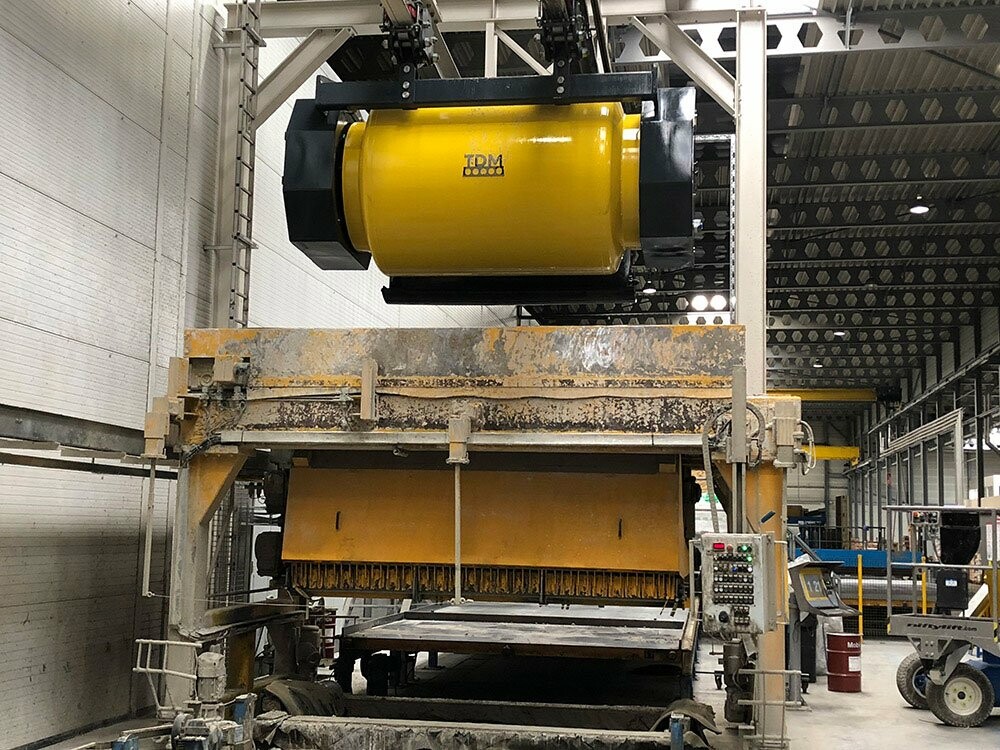In the modern precast concrete industry, accurate dosing, production speed, and reduced material loss are critical factors. Concrete distribution system at a precast concrete plant is a key element of automation that ensures the highest quality of finished products while optimizing all operating costs. The implementation of this system allows enterprises to significantly increase production capacity, minimize the human factor, and achieve perfect uniformity of the concrete mix in each molding cell.

Concrete distribution system: Principle of Operation and Necessity of Implementation
Concrete distribution system is a highly automated complex designed to transport and distribute ready-mixed concrete from the mixing unit directly to the molding machines or stands. The system operates using specialized concrete distributors (shuttle) that move along rail tracks, receiving commands from a centralized control system. The operator or automation system sets the exact volume and unloading speed for each molding point, eliminating overuse and uneven filling of molds. Thanks to this approach, each element of reinforced concrete products — whether it is a floor slab, beam, or wall panel — receives the required amount of mixture, which guarantees compliance with design requirements.
Where Automatic Concrete distribution system Demonstrates Maximum Efficiency
Concrete distribution system are standard for high-capacity plants operating on a continuous production line basis. The most striking examples of application include:
- Production of hollow core slabs: this requires fast and uniform delivery of large volumes of mix to long molding lines.
- Bench molding of facade and wall panels: The system ensures accurate filling of complex shapes with embedded parts, where density and the absence of voids are critical.
- Highly automated carousel lines: on such lines, the concrete distributor is synchronized with the pallet movement cycle, ensuring continuous and accurate targeted feeding in reinforced concrete production.
Key Benefits: Why Choose Automated Concrete distribution system.
The transition from traditional transportation methods to automated distribution provides the plant with a number of undeniable advantages that directly impact financial performance:
1. Increased Productivity: Reduction in molding cycle time due to high speed of movement and precision of unloading.
2. Reduced Cost: Minimization of concrete mix loss during transportation, reduction in energy consumption, and reduction in labor costs.
3. Quality Stability: Ensuring the uniformity of the mixture and the evenness of its placement, which eliminates defects associated with delamination or undercompaction.
4. Improved Working Conditions: Automation of the process makes the workplace cleaner and safer by eliminating heavy physical labor.
5. Maximum Flexibility: Ability to quickly reconfigure the system for different types and volumes of molds.
6. Accurate Accounting: Full control and logging of targeted delivery volumes to each molding position.
Secure the Future of Your Production: Invest in a Reliable Solution
Investing in targeted feeding systems at a reinforced concrete plant is a strategic decision that ensures immediate efficiency gains and long-term competitiveness. Our company offers comprehensive automation solutions that integrate seamlessly into your plant's existing infrastructure. We guarantee precise equipment configuration, rapid commissioning, and full technical support.
Don't let routine operations slow down your progress! Contact us today to receive a customized cost estimate and feasibility study for the implementation of an advanced concrete distribution system that is guaranteed to increase production efficiency and the quality of finished products.
Frequently Asked Questions (FAQ) about Targeted Concrete Delivery
1. What is targeted concrete delivery?
It is an automated system for transporting and accurately dispensing concrete mix from the mixer directly to the molding machines or stands along a specified route.
2. What types of reinforced concrete product manufacturing is this system suitable for?
It is ideal for high-capacity plants using stand molding, carousel lines, and hollow slab production, where high speed and accuracy of mold filling are required.
3. What is the main advantage of targeted delivery compared to traditional methods?
The main advantage is dosing accuracy and minimization of losses. The system eliminates overuse of the mixture and ensures consistent quality of the finished product through uniform placement.
4. How does the targeted delivery system affect the cost of production?
It reduces production costs by minimizing material loss, saving energy, and reducing labor costs associated with manual transportation and laying of concrete.
5. How difficult is it to integrate this system into an existing plant?
Modern systems are designed with the possibility of integration into existing infrastructure in mind. Our specialists conduct a thorough analysis and configuration to minimize disruption to the workflow.
6. Does Concrete distribution system affect the homogeneity of the concrete mix?
Yes, it has a positive effect. Closed transport systems and fast, controlled unloading prevent the mixture from separating and ensure high homogeneity of the mixture in the form.
7. What are the key elements of a targeted delivery system?
The main elements include a concrete distributor (shuttle), rail tracks and a centralized control and automation system.


